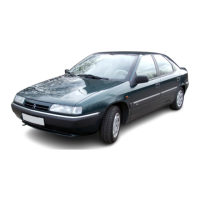Suspension 68 Hydractive 1 and Hydractive 2 explained
96 Citroen XM Internet Reference Version 1.0
3/3/99
68 Hydractive 1 and Hydractive 2 explained
Three computers or ECUs were m use during the Hydractive I phase and each was different from its
predecessor.
H1
The first one was fitted to most 'G' plate vehicles and had external anti jolt diodes, which were also
housed in the computer box at the o/s/f under the bonnet You cam identify These as like old type in-line
fuses, i.e. 2" long black plastic pods.
H2
From RP no. 4859 the next ECU, stamped 'H2' replaced the earlier ones and it had internal diodes.
H3
From RP no. 5539 (approx. late J-reg.) along came the next ECU, stamped 'H3' and it brought with it
improved parameters allowing greater leeway before switching to 'Sport' mode; more importantly, it
coincided with greatly improved wiring looms and the elimination of the stupid and troublesome
earth-blocks under the bonnet on each front Fitch panel and elsewhere, and replace them with simple,
sound, earth blocks, secured on the same points by nuts and serrated washers.
If your XM is one of the early ones with these earthing blocks, I strongly recommend you cut them off
and solder on M6 earth rings and likewise re-secure to earth with serrated washers and nut.
In all These H I systems, She ECU given signals from its five sensors (steering wheel, accelerator
pedal, body movement, road speed and brake switch) compared them with inbuilt parameters and either
energised or isolated the (one) suspension electro-valve. When energised, the electrovalve allowed
fluid passage to the central sphere on both axles (soft mode) when the vehicle rides on the diaphragms
of all three spheres on each axle. When He electro-valve is not energised (firm state), the central sphere
on both axles is cut off, as is all cross-vehicle movement of fluid and the vehicle rides firmly on its four
isolated outer spheres only. This firm state cam of course be chosen by the driver by the over-ride switch
in the cabin, but, in truth, the system could be extremely annoying in that it automatically switched to the
'firm' mode all too readily, even when operating correctly (e.g. traversing a sweeping motorway bend)
and of course, if a fault occurred anywhere, the system cut off the supply to the electro-valve and Thus,
am unnecessary and annoying lack of comfort at times.
EnterHydractive 2!
As from RP no. 5929 (approx. mid-'93) - ECU marked 'H4' - a totally different system as used by the
Then new Xantia VSX was introduced. In this system, The main differences from previous ones are:
(I) The single electro valve, which controlled via hydraulics the lock-out of the centre sphere on both
axles is replaced by two new electro-valves incorporated in new-style stiffness regulators at the centre
spheres on both axles. Both operate simultaneously on the system switching from 'Soft' to 'Firm'
mode.md vice versa.
(2) The H4 computer now has two sets of inbuilt parameters, one for 'Normal' suspension arid one for
'Sport', i.e. there are now two suspension stiffness states and two damping
states. Further, the new design of the stiffness regulators, incorporating a simple ball-valve
automatically cuts down body roll by preventing cross-body transfer of fluid between the suspension
units on both axles. This allows the parameters governing The change-over from 'Soft' to 'Firm' mode to
be changed for both settings giving a more comfortable ride.

